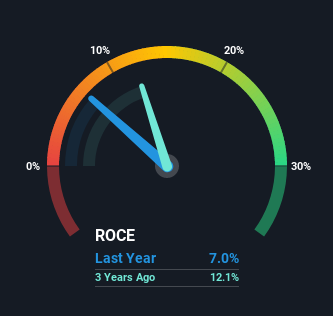- United States
- /
- Luxury
- /
- NYSE:CULP
Culp's (NYSE:CULP) Returns On Capital Tell Us There Is Reason To Feel Uneasy
What underlying fundamental trends can indicate that a company might be in decline? When we see a declining return on capital employed (ROCE) in conjunction with a declining base of capital employed, that's often how a mature business shows signs of aging. This indicates the company is producing less profit from its investments and its total assets are decreasing. And from a first read, things don't look too good at Culp (NYSE:CULP), so let's see why.
What is Return On Capital Employed (ROCE)?
Just to clarify if you're unsure, ROCE is a metric for evaluating how much pre-tax income (in percentage terms) a company earns on the capital invested in its business. The formula for this calculation on Culp is:
Return on Capital Employed = Earnings Before Interest and Tax (EBIT) ÷ (Total Assets - Current Liabilities)
0.07 = US$11m ÷ (US$209m - US$56m) (Based on the trailing twelve months to October 2021).
Thus, Culp has an ROCE of 7.0%. In absolute terms, that's a low return and it also under-performs the Luxury industry average of 14%.
See our latest analysis for Culp

In the above chart we have measured Culp's prior ROCE against its prior performance, but the future is arguably more important. If you'd like to see what analysts are forecasting going forward, you should check out our free report for Culp.
What Does the ROCE Trend For Culp Tell Us?
In terms of Culp's historical ROCE movements, the trend doesn't inspire confidence. About five years ago, returns on capital were 21%, however they're now substantially lower than that as we saw above. And on the capital employed front, the business is utilizing roughly the same amount of capital as it was back then. Since returns are falling and the business has the same amount of assets employed, this can suggest it's a mature business that hasn't had much growth in the last five years. If these trends continue, we wouldn't expect Culp to turn into a multi-bagger.
In Conclusion...
In summary, it's unfortunate that Culp is generating lower returns from the same amount of capital. This could explain why the stock has sunk a total of 73% in the last five years. Unless there is a shift to a more positive trajectory in these metrics, we would look elsewhere.
One final note, you should learn about the 3 warning signs we've spotted with Culp (including 1 which makes us a bit uncomfortable) .
If you want to search for solid companies with great earnings, check out this free list of companies with good balance sheets and impressive returns on equity.
New: AI Stock Screener & Alerts
Our new AI Stock Screener scans the market every day to uncover opportunities.
• Dividend Powerhouses (3%+ Yield)
• Undervalued Small Caps with Insider Buying
• High growth Tech and AI Companies
Or build your own from over 50 metrics.
Have feedback on this article? Concerned about the content? Get in touch with us directly. Alternatively, email editorial-team (at) simplywallst.com.
This article by Simply Wall St is general in nature. We provide commentary based on historical data and analyst forecasts only using an unbiased methodology and our articles are not intended to be financial advice. It does not constitute a recommendation to buy or sell any stock, and does not take account of your objectives, or your financial situation. We aim to bring you long-term focused analysis driven by fundamental data. Note that our analysis may not factor in the latest price-sensitive company announcements or qualitative material. Simply Wall St has no position in any stocks mentioned.
About NYSE:CULP
Culp
Manufactures, sources, and sells fabrics and mattress covers, sewn covers, and cut and sewn kits for use in mattresses, foundations, and other bedding products in the United States, North America, the Far East, Asia, and internationally.
Mediocre balance sheet with very low risk.
Similar Companies
Market Insights
Community Narratives


Recently Updated Narratives

Proximus: The State-Backed Backup Plan with 7% Gross Yield and 15% Currency Upside.

CEO: We are winners in the long term in the AI world

Early mover in a fast growing industry. Likely to experience share price volatility as they scale
Popular Narratives


MicroVision will explode future revenue by 380.37% with a vision towards success


The company that turned a verb into a global necessity and basically runs the modern internet, digital ads, smartphones, maps, and AI.



